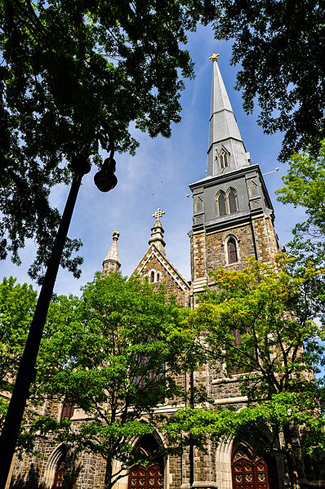“For God, For Country, and for Yale.” This phrase is etched into the stone arches that dot the landscape of Yale University. Yale, though founded by the Puritans for the purpose of missionary training, Christian education, and familiarity with the humanities and Biblical languages, has fallen far away from its original mission. This is nothing new; William F. Buckley Jr. observed this drift during his time at the institution in the 1940s, and many other Catholic institutions and universities are also experiencing the same falling away today.
It is a Catholic truth that beauty will save the world. The Church also teaches that beauty is a gateway to Truth itself. The encounter with beauty is a transcendental experience which, according to St. Augustine, should direct one to the good, true, and beautiful—the ultimate sign of truth penetrating into the world and awakening man’s soul which also enlivens his body.
The great Greek Neoplatonist and mystic philosopher, Plotinus, wrote in his Enneads:
Orthodox. Faithful. Free.
Sign up to get Crisis articles delivered to your inbox daily
For who that truly perceives the harmony of the Intellectual Realm could fail, if he has any bent towards music, to answer to the harmony in sensible sounds? What geometrician or arithmetician could fail to take pleasure in the symmetries, correspondences and principles of order observed in visible things? Consider, even, the case of pictures: those seeing by the bodily sense the productions of the art of painting do not see the one thing in the one only way; they are deeply stirred by recognizing in the objects depicted to the eyes the presentation of what lies in the idea, and so are called to recollection of the truth—the very experience out of which Love rises. Now, if the sight of Beauty excellently reproduced upon a face hurries the mind to that other Sphere, surely no one seeing the loveliness lavished in the world of sense, this vast orderliness, the Form which the stars even in their remoteness display—no one could be so dull-witted, so immoveable, as not to be carried by all this to recollection, and gripped by reverent awe in the thought of all this, so great, sprung from that greatness. Not to answer thus could only be to have neither fathomed this world nor had any vision of that other.
That cosmic reverence and beauty which so deeply moves the human soul was something that moved all men to seek after the Invisible God of the beautiful and ordered Cosmos. Cosmic reverence and the deep appreciation of beauty—as a gateway to truth and the salvation of the world—was also something so deeply integral to the Catholic tradition.
Part of the allure and mystique of Catholicism is its deep appreciation of beauty. The Mass. Cathedrals. Paintings. Statues. For the longest time the Church was a great patron of the arts—capturing in stone, marble, and ink what words cannot express but that which we cannot be silent about.
There is a deep yearning in many people in modern society for something greater than their atomized and alienated selves. Whittaker Chambers, in explaining his embrace of communism to his children, reflected that it was not Marx’s dialectic or philosophy of history that made him join up with the communists. It was that communism offered something to people deeply searching for meaning.
 The kitsch-like commercialization and consumerization of the Mass, and the loss of deep reverence and mystery, has led to a deep metaphysical and ontological poverty in Catholics and the broader culture at large. But in darkness the light shines brightest. In a dark room people cannot help but be drawn to the lone candle.
The kitsch-like commercialization and consumerization of the Mass, and the loss of deep reverence and mystery, has led to a deep metaphysical and ontological poverty in Catholics and the broader culture at large. But in darkness the light shines brightest. In a dark room people cannot help but be drawn to the lone candle.
Yale, as many other places throughout the country, can eat and swallow—whole—your soul and spit you out as an ontologically impoverished person. The culture of mechanism, sterilization, and faux relationships that has become an endemic problem across the United States is the logical ramification of our loss of reverence, beauty, and the encounter with the sublime. Because we have been deprived of encounters with reverence and awe, we have not had any deep experiences of the transcendent.
And in a place like Yale which can capture one’s soul more destructively than Faust’s deal with the Devil, those limited, but bright, flames become ever more noticeable for those with the eyes to see and the patience to experience the unfolding movement of the Mass in all of its glory. St. Mary’s parish is famous for being the church where Fr. McGivney founded the Knights of Columbus. It is also a remarkably beautiful church—stone blocks, all hand-carved, and perfectly mended together to build the church as it reaches up toward the heavens. Wonderful stained glass windows perfectly positioned to create an atmosphere of penetrating sunlight into the church. A beautiful organ, an angelic choir, and a beautiful altar all help to beautify the Mass.
The return to sanity and truth in the world has always begun with the Mass. And this was no different for those seeking beauty, goodness, and truth while having to avoid the temptations that Yale, or other such similar places, has to offer. The Mass has the ability to capture precisely the spirit and transcendent sublimity, with its sacred music, precious works of art and precision architecture, and sense of mystery and reverence, exactly what the modern world is lacking and so desperately needs—the encounter with the mysterium tremendum.
There will be those who say “to each his own.” And there is a certain truth to this, insofar that the Catholic Church has always had liturgies in multiple languages and rites. But what the Catholic Church had always retained, irrespective of language and liturgical variety, was the deep sense of awe, beauty, mystery, and reverence.
The statement “to each his own” today rings hollow because the consumerization and commercialization of the Mass is not the Mass transforming the world but the world transforming the Mass—not for the better and certainly to the detriment of humanity. But the air of St. Mary’s had the aroma of burning candles. When the host was consecrated the church’s bell was rung ever so lightly and reverently, offering a beautiful echo through the lofts. The chants and harmony turned one’s attentions upward to the choir as if it was singing from the heavens with the angelic voices entering the loft and lifting one up to the source of their singing. The experience was nothing short of beautiful … something sacred, holy, and orderly in the midst of a world of artificiality, chaos, and sterilization. This was an instance of the Mass transforming all in attendance. A fellow student and I would always feel a deep peace and indwelling of the Spirit at Mass—something needed for the health of our own souls.
The depreciation of beauty in modernity is not a mere accident. It is a deeply conspiratorial force that is attempting to seduce man’s soul into slumber. Glass and concrete monstrosities dot our landscape. “Dark satanic mills” destroy the green pastures and hills that man had so long depended upon and had a relationship with. The destruction of beauty is the quickest pathway to severing human experience of things transcendent—things divine. The destruction of beauty and transcendental experience has led to the complete destruction of reverence which is a central core to Catholicism and its understanding of man.
One of the great continuities among the pagans and Catholicism was the deep transcendental reverence they had, sans the ancient materialists (like the Epicureans). We are not becoming pagans again; we are becoming hollow mechanical robots completely detached from nature, community, family, and fatherland—the consummation of Bacon, Hobbes, and Locke’s anthropology of the mechanistic consumer. Part of the importance of cosmic reverence is not mere intellectual understanding but also a deep appreciation of the mysterious nature of it all, which is experiential, phenomenological. It grounds man in a deep awe of sublimity; recognizing his place in the world but directing his eyes, like Dante, upward to the stars. The Mass should be able to provide this to everyone—if it did, the Mass would once again transform the world and the human soul. Man’s yearning for and estrangement from reverence and beauty is never going to be satiated by anything less than beauty, mystery, and sublimity. Beauty will lift us to the gates of Heaven itself and direct us to the love that orders the stars and moves the Cosmos.
(Photo credit: St. Mary’s, New Haven, CT. / Society of St. Hugh of Cluny)
